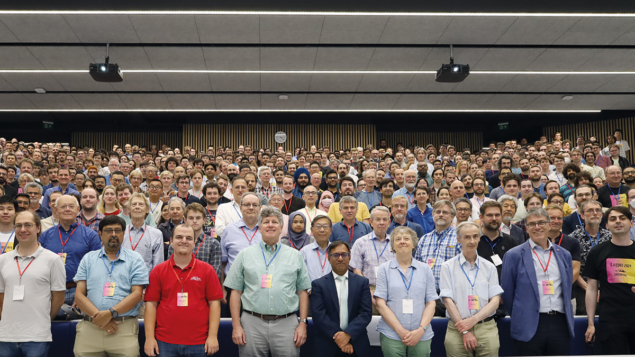
In 1974, Kenneth G Wilson suggested modelling the continuous spacetime of quantum chromodynamics (QCD) with a discrete lattice – space and time would be represented as a grid of points, with quarks on the lattice points and gluons on the links between them. Lattice QCD has only grown in importance since, with international symposia on lattice field theory taking place annually since 1984. Since then the conference has developed and by now furnishes an important forum for both established experts and early-career researchers alike to report recent progress, and the published proceedings provide a valuable resource. The 41st symposium, Lattice 2024, welcomed 500 participants to the University of Liverpool from 28 July to 3 August.
Hadronic contributions
One of the highest profile topics in lattice QCD is the evaluation of hadronic contributions to the magnetic moment of the muon. For many years, the experimental measurements from Brookhaven and Fermilab have appeared to be in tension with the Standard Model (SM), based on theoretical predictions that rely on data from e+e– annihilation to hadrons. Intense work on the lattice by multiple groups is now maturing rapidly and providing a valuable cross-check for data-driven SM calculations.
At the lowest order in quantum electrodynamics, the Dirac equation accounts for precisely two Bohr magnetons in the muon’s magnetic moment (g = 2) – a contribution arising purely from the muon interacting with a single real external photon representing the magnetic field. At higher orders in QED, virtual Standard Model particles modify that value, leading to a so-called anomalous magnetic moment g–2. The Schwinger term adds a virtual photon and a contribution to g-2 of approximately 0.2%. Adding individual virtual W, Z or Higgs bosons adds a well defined contribution a factor of a million or so smaller. The remaining relevant contributions are from hadronic vacuum polarisation (HVP) and hadronic light-by-light (HLBL) scattering. HVP and HLBL both add hadronic contributions integrated to all orders in the strong coupling constant to interactions between the muon and the external electric field, which also feature additional virtual photons. Though their contributions to g-2 are in the ballpark of the small electroweak contribution, they are more difficult to calculate, and dominate the error budget for the SM prediction of the muon’s g-2.
Christine Davies (University of Glasgow) gave a comprehensive survey of muon g–2 that stressed several high-level points: the small HLBL contribution looks to be settled, and is unlikely to be a key piece to the puzzle; recent tensions among the e+e– experiments for HVP have emerged and need to be better understood; and in the most contentious region, all eight recent lattice–QCD calculations agree with each other and with the very recent e+e– → hadrons experiment CMD 3 (2024 Phys. Rev. Lett. 132 231903), though not so much with earlier experiments. Thus, lattice QCD and CMD 3 suggest there is “almost certainly less new physics in muon g–2 than previously hoped, and perhaps none,” said Davies. We shall see: many groups are preparing results for the full HVP, targeting a new whitepaper from the Muon g–2 Theory Initiative by the end of this year, in anticipation of the final measurement from the Fermilab experiment sometime in 2025.
New directions
While the main focus of Lattice calculations is the study of QCD, lattice methods have been applied beyond that. There is a small but active community investigating systems that could be relevant to physics beyond the Standard Model, including composite Higgs models, supersymmetry and dark matter. These studies often inspire formal “theoretical” developments that are of interest beyond the lattice community. Particularly exciting directions this year were the development on emergent phases, non-invertible symmetries and their possible application to formulate chiral gauge theories, one of the outstanding theoretical issues in lattice gauge theories.
The lattice QCD community is one of the main users of high-performance computing resources
The lattice QCD community is one of the main users of high-performance computing resources, with its simulation efforts generating petabytes of Monte Carlo data. For more than 20 years, a community wide effort, the international lattice data grid (ILDG), has allowed this data to be shared. Since its inception, ILDG implemented the FAIR principles – data should be findable, accessible, interoperable and reusable – almost fully. The lattice QCD community is now discussing Open Science. Ed Bennett (Swansea) led a panel discussion that explored the benefits of ILDG embracing open science, such as higher credibility for published results, and not least the means to fulfill the expectations of funding bodies. Sustainably maintaining the infrastructure and employing the personnel required calls for national or even international community efforts to convince the funding agencies to provide corresponding funding lines, but also the researchers of the benefits of open science.
The Kenneth G. Wilson Award for Excellence in Lattice Field Theory was awarded to Michael Wagman (Fermilab) for his lattice-QCD studies of noise reduction in nuclear systems, the structure of nuclei and transverse-momentum-dependent hadronic structure functions. Fifty years on from Wilson’s seminal paper, two of the field’s earliest contributors, John Kogut (US Department of Energy) and Jan Smit (University of Amsterdam), reminisced about the birth of the lattice in a special session chaired by Liverpool pioneer Chris Michael. Both speakers gave fascinating insights into a time where physics was extracted from a handful of small-volume gauge configurations, compared to hundreds of thousands today.
Lattice 2025 will take place at the Tata Institute of Fundamental Research in Mumbai, India, from 3 to 8 November 2025.








